On June 1, in “Purifi Audio’s Pint-Sized Powerhouses,” I described a bit of the history and technology behind Purifi Audio’s class-D 1ET400A amplifier module and PTT6.5W04 midrange-woofer, which Purifi sells as OEM parts to other manufacturers. I also gave my impressions of the sounds of the speaker and amplifier evaluation kits Purifi sent me, as listened to in a typical two-channel setup. One kit was the Eigentakt stereo amplifier, a small, DIY-type case housing two 1ET400a modules, a Purifi-designed gain board, and a Hypex power supply. The other was the SPK5 loudspeaker, which marries the PTT6.5W04 midrange-woofer to a Mundorf air-motion transformer (AMT) tweeter in a basic enclosure mostly made of plywood. At the end of that article, I wrote that I hoped to have both products measured, and the results posted online, by “July 1 or, at the latest, August 1.”
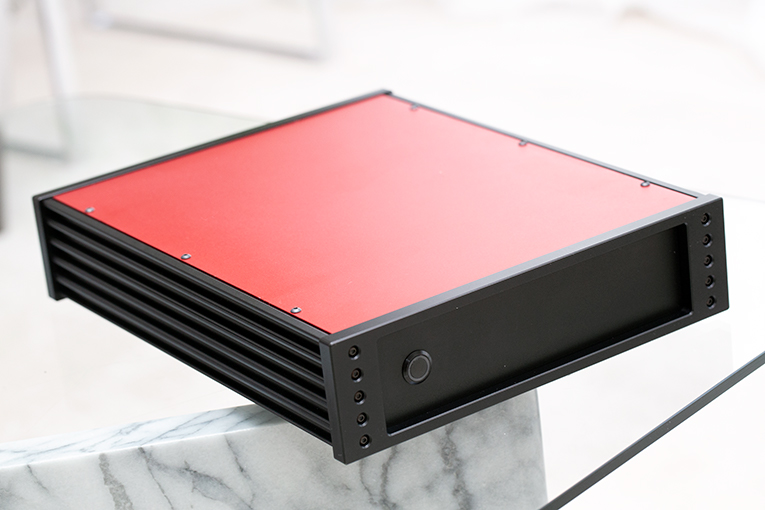
But July 1 and August 1 flew by with no measurements posted. As I write this, the anechoic chamber in which we measure speakers, at Canada’s National Research Council (NRC), is still closed due to the COVID-19 lockdown. As for measuring the Eigentakt, delivery of our Audio Precision APx555 B Series audio analyzer, widely considered the best device in the world for measuring audio electronics, has been delayed. In response to lots of pestering by me, the NRC has said that we should be able to resume measuring speakers in September -- I hope to post my discussion of the SPK5’s trials on the first of October or November. And while still waiting for our APx555 analyzer to arrive, we were able to use another APx555 to measure the Eigentakt. Those measurements are the subject of this article.
About the measurements
The real purpose of these measurements is to assess Purifi Audio’s claim that the 1ET400A is a breakthrough in providing ultra-low distortion from 20Hz to 20kHz, aka the audioband.
I worked on this piece with two of our tech-savvy reviewers, Diego Estan and S. Andrea Sundaram, and we decided to include nine graphs that we think best characterize the technical performance of the Eigentakt amplifier. Each displays the results of a specific test, and is preceded by a short explanation of the conditions under which that measurement was performed, followed by an explanation of the results. If you’re unfamiliar with these sorts of graphs, you might find them confusing. Nonetheless, I think it will be worth your while to give them and my explanations a careful reading.
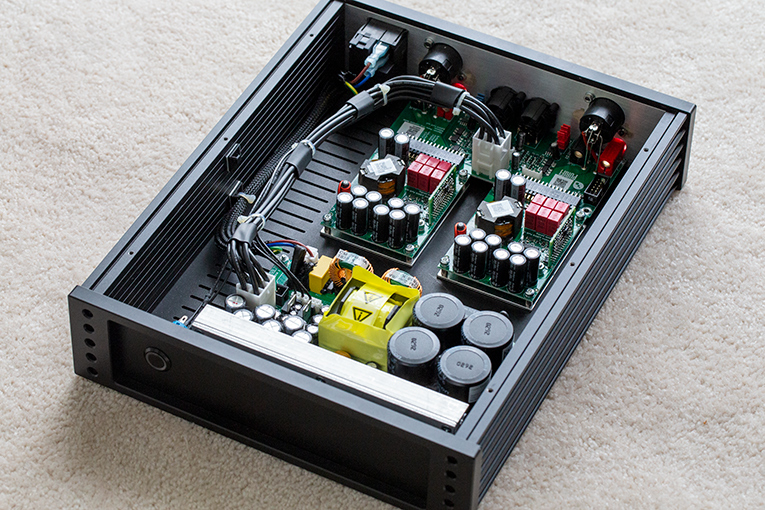
Another important thing to understand: Just as no one can listen to a pair of 1ET400A amplifier modules without a power supply, and in most cases an extra gain board, the measurements below are of the entire Eigentakt amplifier, just as we listened to it. (In one instance, explained below, we disabled the gain in the board that precedes the 1ET400As, to learn more about the distortion of the 1ET400As.) For this reason, our measurements won’t necessarily mirror those of another company’s amplifier that uses Purifi’s 1ET400A amplifier modules in conjunction with a different power supply, gain board, internal wiring, connectors, etc. Still, our measurements provide a good indication of what can be achieved by a single-box, two-channel amplifier comprising two 1ET400A modules and the sorts of ancillary parts Purifi thinks work best with them.
Bench Mode, 1kHz signal, 10W output, 4-ohm load
The first image below is an example of what the Audio Precision APx555 can display when operated in Bench Mode. In this instance, it represents the Eigentakt’s 10W output of a 1kHz signal into a 4-ohm load, both channels driven.
The top-left quadrant of the image, Scope, shows the sinewave of the 1kHz signal. The top-right quadrant, FFT, shows the spectrum of the signal’s fast Fourier transform, including the 1kHz fundamental (the tallest spike, which rises to 0dB), followed by the fundamental’s second and third harmonics (the two short spikes to its right, which are evident at 2 and 3kHz).
The bottom-left quadrant displays the root mean square (RMS) output in voltage and watts. Though not perfectly matched, the channels are extremely close, their outputs differing by an inaudible 0.018dB. The bottom-right quadrant . . .
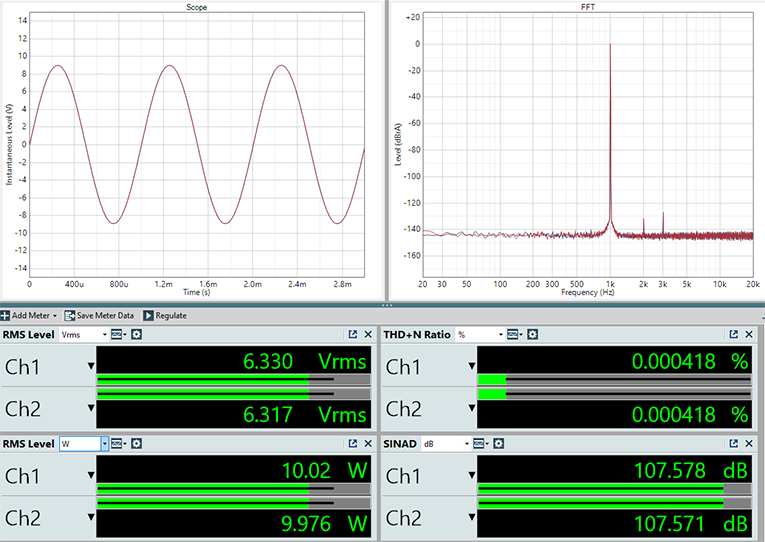
. . . shows the total harmonic distortion plus noise (THD+N) ratio expressed as a percentage: 0.000418% for the left and right channels. According to Audio Precision (AP), the THD+N ratio is derived as follows: “the rms level of the measured distortion plus noise (the signal with the stimulus tone removed) is divided by the rms level of the total signal.” The inverse of the THD+N ratio is the ratio of signal to noise and distortion (SINAD), expressed here in decibels (dB). The SINAD for both channels, shown at the bottom right, is 107.6dB.
Though Purifi doesn’t supply this exact 1kHz at 10W in 4 ohms spec data, these THD+N ratios for both channels are extraordinarily low, and the SINADs are very high, for an amplifier of any type. These are good things: low THD+N and high SINAD are what make possible sound that’s free of colorations produced by the amplifier.
Bench Mode 1kHz signal, 100W output, 4-ohm load
This next graph is similar to the first -- it’s still a 1kHz signal into 4 ohms, but the power output has been raised to 100W, as revealed in the voltages and watts into 4 ohms shown at lower left.
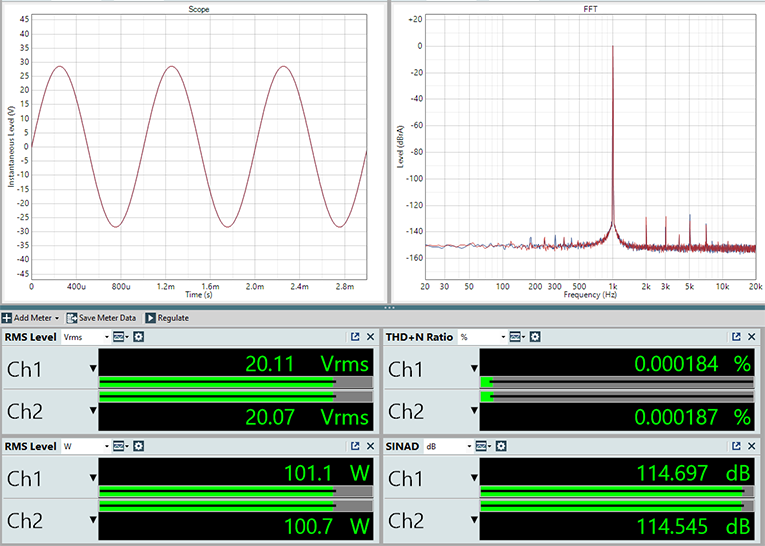
With the higher power output, the sinewave remains cleanly reproduced in Scope. But in addition to the second and third harmonics, FFT shows other harmonics, though these are extremely low in level -- all are near or below -130dB, or 0.0000315%.
Has the increase in power caused more distortion and noise? Yes, but the increase in the signal is much greater, thereby causing a net decrease in the THD+N ratio. Look at the distortion figures of 0.000184% and 0.000187% for channels 1 and 2 at bottom left -- they’re actually lower than the THD+N figures for the 10W signal. Commensurately, the SINAD for each channel has risen by 7dB compared to the 10W SINADs. Since the voltage at the output has increased by 10dB, the rise in SINAD of 7dB indicates that the increase in noise and/or distortion is small compared to the increase in signal level: 3 vs. 10dB.
Also important to note is that the 100W THD+N measurements approach the limits of the AP analyzer. With the AP in loopback mode -- in which the APx555 analyzes its own generator’s output -- and outputting the level required to get 20VRMS out of the Purifi amplifier (i.e., about 0.8VRMS), the THD+N levels are in the 1.2µVRMS neighborhood. The 0.000184% THD+N ratios measured in the Purifi’s output at 100W equates to a THD+N level of only 37µVRMS, or about 30 times more noise than the analyzer. When we consider that the Purifi is applying 25x voltage gain, we can see that in doing so it adds hardly any noise of its own. As a result, at the 100W level, the amplifier produces so little distortion that the true THD+N ratio figures might actually be lower than what we’ve measured. But the level we have been able to measure is extremely low indeed.
Distortion as a function of power output and frequency (pre-gain enabled)
The graph below plots the THD+N from 20Hz to 20kHz (aka the audioband) for power outputs of 1W (red trace), 10W (magenta), 70W (blue), and 150W (cyan), all into 4 ohms, both amplifier channels driven.
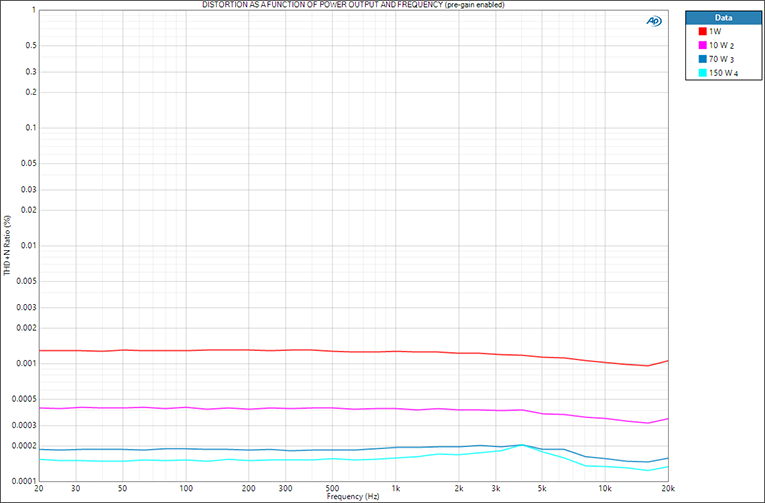
As you can see, each time the power output rises, the THD+N ratios across the entire audioband fall -- 1W is the worst, at <0.002% across the audioband, while 150W is the best, at <0.0002% across most of the audioband, and just touching 0.0002% at 4kHz. All told, the Eigentakt’s extraordinarily low levels of noise and distortion approach but don’t quite meet Purifi’s claim of 0.00017% distortion for the 1ET400A modules on their own. We investigated a little further . . .
Distortion as a function of power output and frequency (pre-gain bypassed)
The next graph shows the same test under the same conditions as above, but with the gain board preceding the Eigentakt’s amplifier modules turned off, which Purifi has made possible with DIP switches on the board itself. This measurement gives a better idea of the distortion produced by the 1ET400As alone.
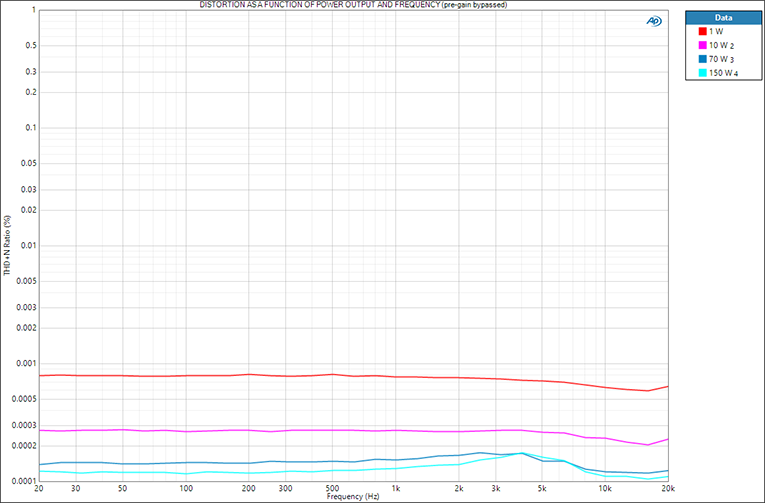
It shows that, again, as the power increases, the THD+N ratios decrease. But if you look at each distortion trace, you’ll see that the distortion ratios are lower than in the preceding graph, for which the gain board was enabled: 1W (red) is now <0.001% across the audioband, while 150W (cyan) is well below 0.0002% and approaches 0.0001%. The THD+N figures for 10W (magenta) and 70W (blue) of power output are also lower.
In sum, this means that the board’s added voltage gain predictably contributes a tiny bit of noise and distortion -- the addition of any active circuitry and gain is bound to increase THD+N. More important, it tells us that Purifi’s claim of a THD+N ratio of 0.00017% for 100W output into 4 ohms is credible -- our 70W and 150W measurements are both below 0.0002%.
Distortion as a function of power output and frequency
With the gain board reenabled for this and all the measurements that follow, the chart below shows the THD+N ratios vs. power output for 4- and 8-ohm loads, both channels driven. The four traces are often so close together that they’re superimposed, making it difficult to tell them apart -- where you can see them, the blue and red traces are, respectively, the left and right channels with 4-ohm loading, while cyan and magenta respectively represent the left and right channels with 8-ohm loading.
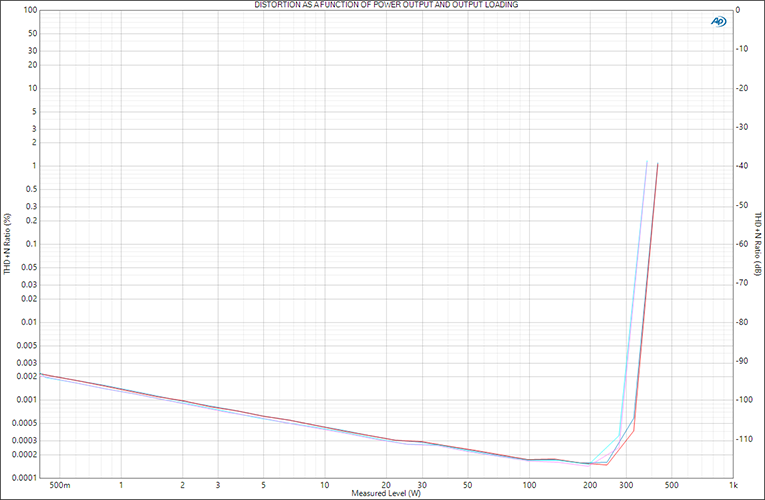
Purifi specifies that the 1ET400A module can output 200W into 8 ohms or 400W into 4 ohms with less than 1% distortion. In audio, 1% distortion is widely considered to be the point of clipping, or a level of distortion high enough to be heard.
These traces show us that as power output is increased, the ratio of THD+N to signal decreases up to around 200W, at which it’s <0.0002%. Beyond 200W, for both 4- and 8-ohm loads, the ratios of distortion increase, but don’t hit 1% until 375W for an 8-ohm load and 425W for 4 ohms. From this it’s safe to say that the Eigentakt we tested exceeded Purifi’s power-output spec. Also noteworthy to me is how low the THD+N ratio is at 200W into 4 or 8 ohms. In typical listening, most people will never need so high a power output -- the Eigentakt should guarantee them sound that’s virtually free of distortion.
Frequency response of output voltage as a function of output loading
Below is what most people who read measurements will recognize as a frequency-response graph. It shows the output signal relative to the measured output at 1kHz, in dB, across a frequency range. This measurement was performed with loads of 2 ohms (cyan trace), 4 ohms (blue), and 8 ohms (magenta), and an open circuit with no load attached to the amplifier (red). The output power was maintained at 10W, and the 0dB reference was at 1kHz, with the 4-ohm load. Although Purifi doesn’t specify into 2 ohms, a challenging load for many amplifiers, this graph shows that the Eigentakt is indeed stable into that load: the 2-ohm trace (cyan) is as even and well behaved as the traces representing the other loads.
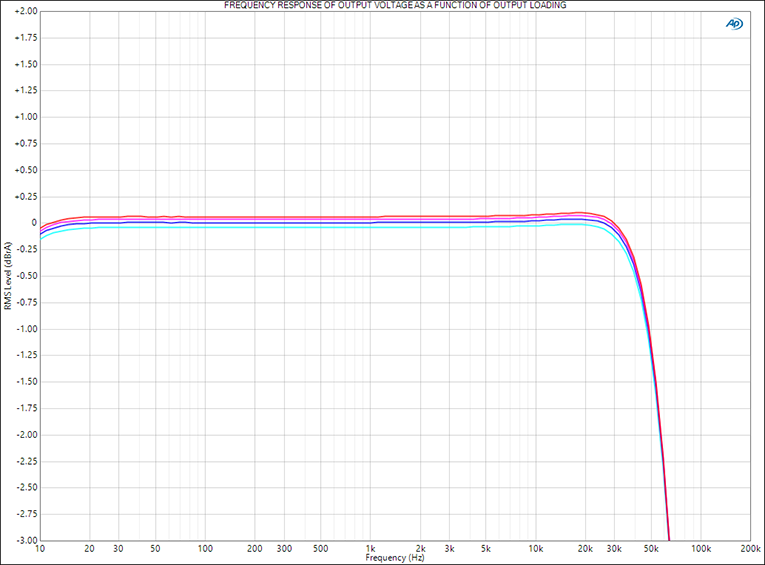
These curves reveal many interesting things. First, the Eigentakt’s frequency response is essentially ruler-flat from below 20Hz to above 20kHz, regardless of load. Not all class-D amplifiers exhibit such flat frequency responses into varying loads -- with many of them, the high-frequency output diminishes as the load decreases from 8 to 4 to 2 ohms, resulting in the sort of rolloff visible in the graph above but at far lower frequencies, often within the audioband. The result of such a premature rolloff is sound that grows more dull as the load impedance decreases. In the case of the Eigentakt, that rolloff doesn’t begin until about 30kHz, far above the audioband.
Important: The slight droop beginning at about 16Hz does not indicate that the amplifier is rolling off the low end, but is the result of a high-pass filter (HPF) enabled in the APx555 that prevents direct current (DC) from entering the analyzer. Without this HPF, the line to 10Hz would have shown no droop, and, according to Purifi, would stay that way to 0Hz, or DC.
Another takeaway from this graph is the close spacing of the traces -- all within about 0.1dB of each other. This indicates the amplifier’s very low output impedance across its operating range, and its commensurately high damping factor. Although it’s not shown here, when we measured the output impedance and calculated the damping factor with a 4-ohm load, we got a very high 1600 from 20Hz to 4kHz -- and from 4 to 20kHz the damping factor rose even higher, to almost 2000.
Purifi claims that their amplifier technology provides “load-invariant response.” The Eigentakt’s flat frequency response across every load we tested it for, and its high damping factor, indicate that that claim is valid.
Intermodulation distortion spectrum at 18+19kHz, 10W, 4 ohms
The harmonic distortion of power amplifiers is a frequent subject in audio writing and discussions, but many feel that intermodulation distortion is at least as important. Intermodulation distortion occurs when two or more frequencies are simultaneously introduced as a test signal, resulting in frequencies additional to the two test frequencies measured at the output -- frequencies that, ideally, should not be there at all. One of the most popular ways to test an amplifier’s intermodulation distortion is to send it a 18+19kHz sinewave signal and measure what comes out at the amplifier’s output. Below we can see the FFT output spectrum (at 10W) when we fed the Eigentakt such a signal -- the tallest spikes are at the two original test frequencies of 18 and 19kHz.
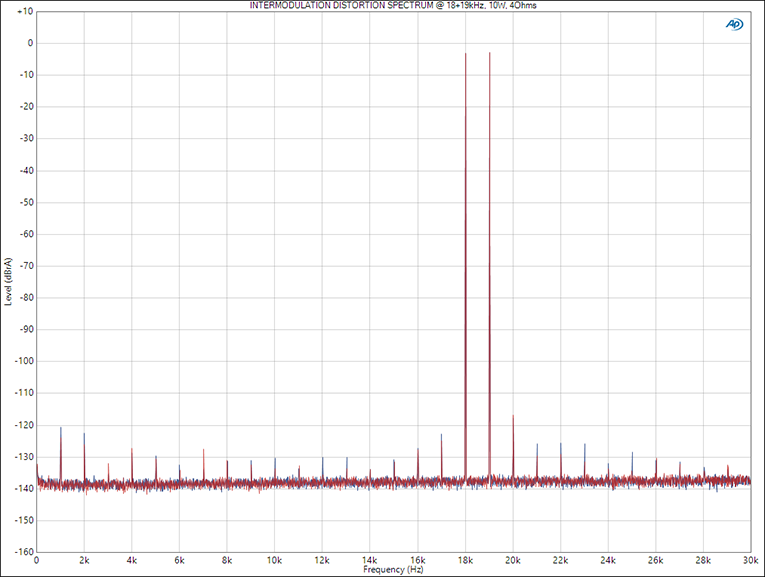
As you can see, the Eigentakt’s output is not entirely free of intermodulation-distortion products, as evidenced by the much shorter spikes that occur at 1kHz intervals from 1kHz to 29kHz, but these byproducts are, as Purifi says, “negligible.” The three greatest distortion byproducts are at 1, 2, and 20kHz, and they all hover around -120dB, or 0.0001% of the signal. All other spikes are at around -130dB, or about 0.00003% -- so low in level as to be almost not worth mentioning.
10kHz squarewave
The graph below shows the output of the left channel when driven by a 10kHz squarewave signal into a 4-ohm load at 10W. Ideally, the output squarewave should have perfectly square (90°) corners, just like the input squarewave. For this measurement, the AP’s own bandwidth was set to its maximum of 1MHz, to ensure that the AP itself was not a limiting factor in the reproduction of the squarewave.
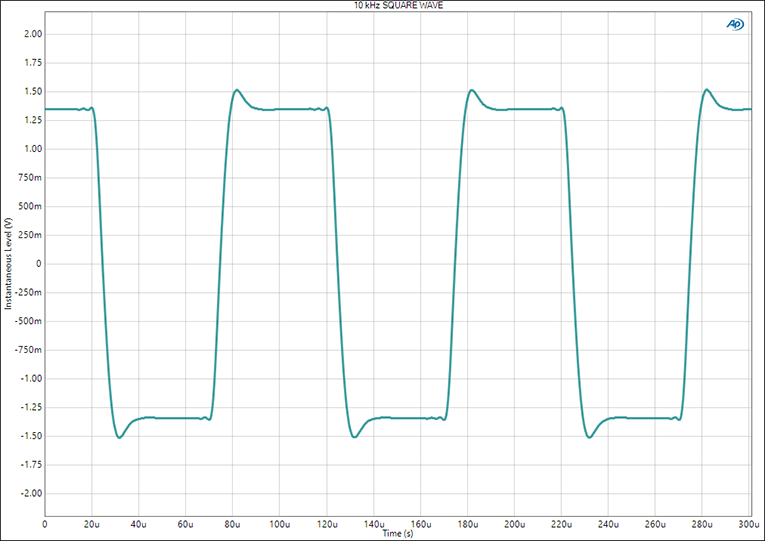
Each rise and fall shows a bit of overshoot -- the small, triangular protrusions at top left and bottom right of each wave. This might simply be an indication of the amplifier’s bandwidth limitations. An ideal squarewave comprises an infinite number of sinewave harmonics. If the system reproducing the squarewave is bandwidth limited (as every system is, to varying degrees), the edges of the squarewave will soften and overshoot as the sinewave harmonics that make up the edges become visible. But we can’t be sure what accounts for this, and since Purifi provides no squarewave graphs, we have nothing to compare with ours. Still, we feel this measurement is useful for comparison to other amplifiers’ squarewave behaviors.
FFT spectrum of 500kHz switching frequency relative to a 1kHz tone
A class-D amplifier such as the 1ET400A relies on a switching oscillator to convert the input signal to a pulse-width modulated (PWM) squarewave (on/off) signal before sending the signal through a low-pass filter to generate an output signal. The 1ET400A’s oscillator switches at a rate of about 500kHz, and this graph plots an FFT spectrum of the amplifier’s output as it’s fed a 1kHz sinewave. The FFT ranges from 1kHz (look at the leftmost part of the graph and you’ll see a blue line against the edge that ranges from 0 to -120dB) to beyond 1.2MHz, for both the left (blue) and right (cyan) channels.
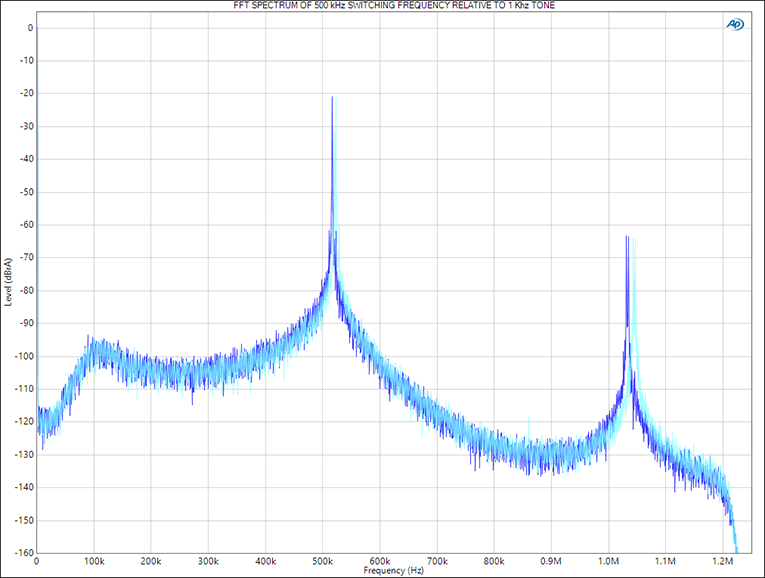
The 1kHz trace represents the input signal at full scale (0dB). The second-highest peak is just above 500kHz, at -20dB relative 1kHz, with a third peak just above 1MHz (the second harmonic of the first peak), at -63dB relative 1kHz. Those two peaks -- the fundamental and its second harmonic -- are direct results of the switching oscillators in the Eigentakt’s 1ET400A modules. The noise around those very-high-frequency signals are in the signal, but all that noise is far above the audioband -- so it should be inaudible -- and so high in frequency that any loudspeaker the amplifier is driving should filter it all out anyway: the outputs of most tweeters begin to fall off not far above 20kHz. Again, Purifi doesn’t provide a graph of this measurement, so we have nothing to compare with ours, but we thought it interesting enough to include here.
It fits! Now for the final piece of the puzzle . . .
In my June feature, I wrote that “I was bowled over by the Purifi Eigentakt’s sound and operation. It turned on silently, made almost no noise, provided more than enough power while generating hardly any heat, and passed music through so transparently, at volume levels from low to high, that it left me in near disbelief that so small a box could accomplish so much.”
Now I can say that the Eigentakt’s measured performance also deserves such praise -- our measurements have gone a long way toward corroborating what I heard. The Eigentakt not only exceeded its specified power output while producing levels of distortion and noise lower than those of most other amplifiers made today, it challenged the powers of resolution of one of the world’s best audio analyzers -- the Audio Precision APx555. In passing along audio signals with low distortion and almost entirely free of colorations, and operated within its power limits, the Eigentakt is about as good as it gets -- regardless of price.
Our next step is to measure Purifi Audio’s SPK5 loudspeaker. Here’s hoping that NRC’s lockdown can soon end, and that we can return to their anechoic chamber to fit the final piece into the Purifi puzzle.
. . . Doug Schneider
das@soundstagenetwork.com






















